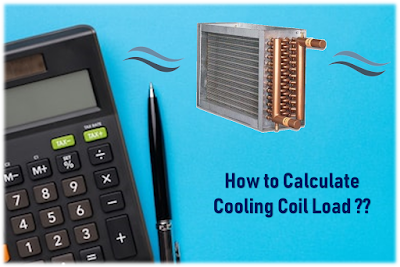In designing an Air Conditioning system, determining the heat load of a conditioned space will be the first most important step. And once it is determined then the next immediate step is to calculate the required supply air and determine cooling coil sizing accordingly. A wrongly estimated cooling coil load will have a drastic effect on the efficiency of the entire air conditioning system. In this article am going to explain how to determine cooling coil size with a simple case example.
Cooling Coil Sizing Calculation - Case Example:
Consider a space to be conditioned is having below heat loads, outdoor conditions in summer and comfort requirements as below
- Summer sensible heat gain: 10 kW.
- Latent heat gain: 3 kW.
- Internal design air condition: 20ºC, 50% sat.
- Summer external design air condition: 28ºC, 50% sat.
- Occupancy minimum outdoor air requirement is 325 l/s. - (Changes as per the type of room - Office space, Auditorium, Lobby etc)
- Acceptable supply temperature in summer: 14ºC.
Step1:
Supply air volume and temperature - considering the cooling case
The sensible heat is given by:
Qs = m cp Δt
10 = m x 1.026 × (20-14)
m = 1.626 kg/s
Qs = sensible load
cp = Specific heat capacity of air in kJ/kg K
Δt = Temperature differential between supply air and room air
m = mass flow rate of air in kg/s
The latent gain is given by:
Ql = m hfg Δg
3 = 1.626 × 2450 × Δg
Δg = (gr – gs) = 0.000753 kg/kg
Ql = Latent heat load
m = mass flow rate of air in kg/s
hfg = Latent heat of vaporisation in kJ/kg
Δg = moisture content differential between supply air and room air, ie (gr – gs)
From psychrometric data the space moisture content gr is 0.00738 kg/kg. The supply air moisture content gs is given by:
gs = 0.00738 – 0.000753 = 0.00663 kg/kg
The summer supply condition is therefore 1.626 kg/s at 14ºC and ag of 0.00663 kg/kg.
The humid volume at this condition is 0.8218 m3/kg, so the required volume flow rate is:
V= m x v = 1.626 × 0.8218 = 1.336 m3/s
Step2:
Considering the minimum outdoor air requirement of 325 l/s this gives a value of 25% outdoor air and 75% recirculated.
Coil capacity - A mix condition can now be found and the cooling coil sized.
m x tm = (mr × tr) + (mo × to)
1.626 × tm = (0.75 × 1.626 × 20) + (0.25 × 1.626 × 28)
tm = 22ºC
m x gm = (mr × gr) + (mo × go)
1.626 × gm =(0.75 × 1.626 × 0.00738) + (0.25 × 1.626 ×0.01210).
gm = 0.00856 kg/kg
Step3:
Q = m Δh = (ha – hm)
From psychrometric data, using t and g
- Enthalpy at mix condition is 43.88 kJ/kg
- Enthalpy at supply condition is 30.83 kJ/kg
Qc = 1.626 × (43.88 – 30.83)
= 21.22 kW
Cooling Coil TR Calculated: 6TR
Cooling medium mass flow rate - Calculate the required mass flow rates of chilled water for water to air heating coil.
Assume flow and return chilled water temperatures of 6 and 12ºC
Qc = w cp Δt
Where Δt = (tf – tr)
21.22 = w x 4.2 × 6
w = 0.84 kg/s = Cooling water flow rate through the coil
Assumptions:
• Fan and duct gains have been ignored
• Coil contact factors have not been included in this simple example
• The apparatus dew point) of the coil has also not been considered.
Ref: CIBSE Guide






Sir
ReplyDeleteIf the 5 kw evaporator is designed at -4° evaporting, what size will come? how to calculate
If the 5 kw evaporator is designed at -4° evaporting, what size will come? how to calculate
ReplyDeleteif 8 kw evaporator is designed at -22 evaporator what size will come sir how to calculate sir please
ReplyDeleteThanks for publishing such great information. You are doing such a great job. This information is very helpful for everyone. Take a look at this Fan Coil Repair Service in Chicago. Thanks.
ReplyDeleteΔg = (gr – gs) = 0.000753 kg/kg
ReplyDeletethis part is not clear to me please thanks.
I like your article. The concept is cleared by your encouraging post. I need more articles on this topic. Keep uploading more articles. Now it's time to avail earbuds for more information.
ReplyDeletehow did u calculate cP
ReplyDeleteHow did you get 0.8218 as humid volume
ReplyDeleteYou are providing such an informative article here eaton vfd You have described everything which is easily understandable to everyone. Keep sharing this kind of articles, Thank you.
ReplyDeleteExcellent company for AC services. ac repair charleston sc
ReplyDeleteReplacement eliminated all my HVAC problems. hvac replacement
ReplyDelete